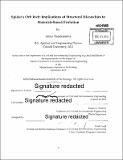| dc.contributor.advisor | Markus J. Buehler. | en_US |
| dc.contributor.author | Tarakanova, Anna | en_US |
| dc.contributor.other | Massachusetts Institute of Technology. Department of Civil and Environmental Engineering. | en_US |
| dc.date.accessioned | 2016-03-25T13:39:42Z | |
| dc.date.available | 2016-03-25T13:39:42Z | |
| dc.date.copyright | 2015 | en_US |
| dc.date.issued | 2015 | en_US |
| dc.identifier.uri | http://hdl.handle.net/1721.1/101842 | |
| dc.description | Thesis: S.M., Massachusetts Institute of Technology, Department of Civil and Environmental Engineering, 2015. | en_US |
| dc.description | Cataloged from PDF version of thesis. | en_US |
| dc.description | Includes bibliographical references (pages 65-69). | en_US |
| dc.description.abstract | Among a myriad of spider web geometries, the orb web presents a fascinating, exquisite example in architecture and evolution. Its structural component, the silk protein, is an exemplary natural material because its superior properties stem intrinsically from the synergistic cooperativity of hierarchically-organized components, rather than from the particular properties of the building blocks themselves. By bridging together different levels of hierarchy in the web, we elucidate the mechanisms by which structure at each composite level contributes to organization and material phenomena at subsequent levels, demonstrating that the web is a highly adapted system where both material and hierarchical structure across all length-scales is critical for its functional properties. Further, the material hierarchy scheme within the orb web is exploited to address questions of silk evolution. Spider orb webs can be divided into two categories distinguished by the capture silk used in construction: cribellate orb webs composed of pseudoflagelliform silk coated with dry cribellate threads and ecribellate orb webs, composed of viscid flagelliform silk fibers, coated by adhesive glue droplets. Cribellate capture silk is generally stronger but less extensible than viscid capture silk and a body of phylogenic evidence suggests that cribellate capture silk is more closely related to the ancestral form of capture spiral silk. Here, we use a coarse-grained web model to investigate how the mechanical properties of spiral capture silk affect the behavior of the web system, illustrating that more extensible capture spiral silk yields a decrease in the web's energy absorption, suggesting that the function of the capture spiral shifted from prey capture to other structural roles. Additionally, we observe that in webs with more extensible capture silk, the effect of thread strength on web performance is reduced, indicating that thread extensibility is a dominant driving factor in web diversification. In this thesis, we propose a novel model-centered materials-hierarchy based approach to studying evolutionary trends and suggest possible applications for other fields. | en_US |
| dc.description.statementofresponsibility | by Anna Tarakanova. | en_US |
| dc.format.extent | 69 pages | en_US |
| dc.language.iso | eng | en_US |
| dc.publisher | Massachusetts Institute of Technology | en_US |
| dc.rights | M.I.T. theses are protected by copyright. They may be viewed from this source for any purpose, but reproduction or distribution in any format is prohibited without written permission. See provided URL for inquiries about permission. | en_US |
| dc.rights.uri | http://dspace.mit.edu/handle/1721.1/7582 | en_US |
| dc.subject | Civil and Environmental Engineering. | en_US |
| dc.title | Spider's orb web : implications of structural hierarchies to materials-based evolution | en_US |
| dc.title.alternative | Implications of structural hierarchies to materials-based evolution | en_US |
| dc.type | Thesis | en_US |
| dc.description.degree | S.M. | en_US |
| dc.contributor.department | Massachusetts Institute of Technology. Department of Civil and Environmental Engineering | |
| dc.identifier.oclc | 941815506 | en_US |
